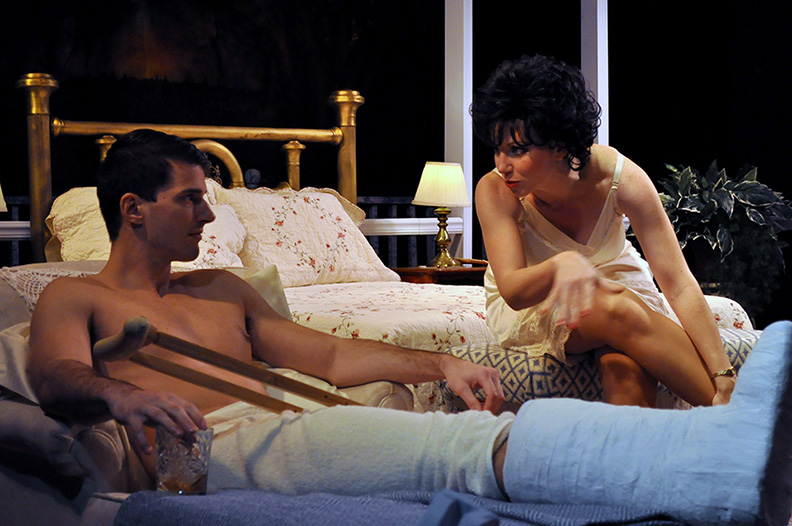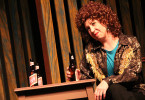Cat on a Hot Tin Roof
Reduxion Theatre Company
8 p.m. June 19-20, 2 p.m. June 21 (Through June 27)
OCCC Visual and Performing Arts Center Theater | Oklahoma City
Putting on a successful play shouldn’t be complicated. First you select a worthy script, then engage the right director and designers, and, finally, bring in strong actors to perform said script. You’ll then have a satisfying evening of theater for your audience. Reduxion Theatre Company’s Cat on a Hot Tin Roof serves as a case in point.
A production doesn’t have to be the greatest thing ever staged to be successful, but it first depends on the script. People put the label “classic” on about anything nowadays, but this Tennessee Williams, well, classic, stands up to time and revival as well as any American play. And why wouldn’t it? A sordid tale of lust, avarice, and mendacity on a 28,000-acre Mississippi plantation, Cat on a Hot Tin Roof makes us both laugh and wince, sometimes at the same time.
It all begins with Margaret, played here by Crystal Ecker. The first act belongs to Margaret, and Ecker finds the right balance between sultry and vulnerable. She gives a strong technical performance. It’s a hot “summuh,” and Maggie can’t stand her in-laws’ “triiibe” of children known as the “no-neck mohnstuhs.” Maggie comes from the bottom end of Southern aristocracy. When she made her debut, she had only two evening gowns, and one of those was a hand-me-down. She married up in society and will do anything to keep her social position. The actor playing Maggie must get the play off to a good start, and Ecker does so with authority.
Maggie married up to Brick (Marty Rogers), who is laconic and looking good in nothing but a bath towel and a leg cast. A star high school and college athlete, Brick quit his job as a television sports announcer to spend most of his time bending his elbow. For such a nonentity, this Brick sure gets lots of attention.
Regular theatergoers will not be surprised to hear that much of this production’s success comes from the actors playing Brick’s parents, Big Daddy and Big Mama: Mark Loftis and Brenda Williams. Loftis and Williams played these roles in a 2007 production, and a few years’ seasoning enriches their performances here. Just as the first act belongs to Margaret, the second act is Big Daddy’s, who’s a self-made man, working his way up on the plantation from laborer to owner. Loftis menaces the family as Big Daddy, and his performance both amuses and makes us uncomfortable, as it should.
Big Mama counterbalances Big Daddy’s brute force. She’s the quintessential — or maybe stereotypical — Southern woman, who’s bound to hold the family together, no matter what. The performance Loftis achieves through histrionics, Williams equals with subtlety. Her Big Mama shows strength and resolve, but also fragility. It’s wince-inducing to see Williams’s Big Mama endure her husband’s cruelty. Loftis and Williams are younger than their characters, so we may be graced with performances from them in these roles again. Let’s hope so.
Big Mama and Big Daddy have an older son and daughter-in-law, Gooper and Mae. Craig Pruitt plays Gooper as an opportunistic lawyer with a self-serving, and maybe premature, plan for the plantation after Big Daddy dies. Claire Powers gives a strong performance as Mae, a former beauty queen and now-pregnant mother of five, whose ambition equals Maggie’s. Powers runs the gamut from giddy to catty.
Terry Veal directs with design by Uldarico Sarmiento (scenery) and Jeffrey Meek (costumes). Angela Marks Hawthorne’s soft lighting design is especially effective in the tiny CitySpace, where the production debuted over the weekend. Some action and dialog take place offstage, where Veal gives much-appreciated attention to detail. You recognize the sharp taps of a croquet game offstage before anyone onstage mentions it. (The production transfers to the Visual and Performing Arts Center at Oklahoma City Community College for the remainder of its run. Both the play and the audience will be on the stage of the large theater. It’s hard to imagine how this will work, but the essentials of the production remain the same.)
Late in the play, Big Daddy says the room is redolent of the “odor of mendacity.” But in Cat on a Hot Tin Roof, the truth hurts as much as lies. That’s why this 1955 play remains relevant and revival worthy.





